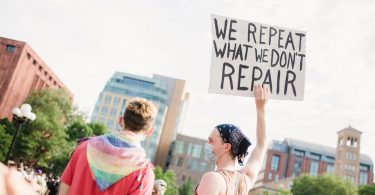Speaking at the Women of the World Festival this weekend, Shabana Kausar, black feminist activist and Women’s Aid National Schools Engagement Officer; Sasha Havlicek, founding chief executive officer of the Institute for Strategic Dialogue; Åsne Seierstad, author of One of Us: The Story of Anders Breivik and the Massacre in Norway, discussed how and why women join extremist movements, and the role that gender inequality plays in these choices, and whether feminism has failed to empower women and stop them from joining extremist organizations.
News of three British girls, Shamima Begum, 15, Amira Abase, 15, and Kadiza Sultana, 16, travelling to Syria to join the Islamic State has dominated British media for the past few weeks. Yet women’s participation in extremism is as old as time.
“Young women are just as capable of extremism as men. This isn’t new,” explained Sasha Havlicek, CEO of The Institute for Strategic Dialogue, speaking at the Women of the World Festival on Sunday 8th March.
“Of course, there are unique aspects in what we are seeing,” she continued. Indeed, official figures state that there are 3000 Europeans that have left for Syria and Iraq to join the Islamic State, of which 550 are women, “These are unprecedented numbers.”
Radicalisation as self-expression
Asne Selerstad, author of One of Us: The story of Anders Breivik and the Massacre in Norway, expanded on the unique side of what the media has dubbed ‘jihadi brides,’ “The difference with Chechnya or Palestine, where we have seen female fighters, is that those conflicts were local. The women saw and experienced atrocities, destruction and the loss of their family. They are radicalized because they think this is the only way to be heard. They have nothing else.”
“Yet [Begum, Abase, and Sultant] are middle-class, educated, A-grade students from stable homes,” stated Lucy Manning, BBC News special correspondent, who was chairing the event. “Are they brainwashed?” she asked.

“People find it shocking that women can be violent.”
Focusing on the pull factors, Havlicek explained, “Women are the target because they are underestimated by the security services, and the attention they gain from media has a huge PR value. People find it shocking to hear that women can be violent.”
According to Havlicke, the Islamic State’s propaganda would make most marketing organisations envious. While mainstream media coverage focuses on the violence and beheadings, Havlicke pointed to the other side of the ISIS’s propaganda machine: “There’s an empowerment narrative, they are building a new state, a heroic project, a new world, and these girls can be part of this.”
Asne Selerstad’s work on the 2011 Norway massacre, in which Anders Berivik killed 77 people, has lead her to similar conclusions: “He called the attack a ‘book launch.’ He wanted to be seen and heard.”
Tying it back into feminism, Shabana Kausar, Women’s Aid National Schools Engagement Officer, agreed, “This is about empowerment. These women want to write their stories.”
Kausar that feminism often is not working for young women of colour, “It’s supposed to empower.” Yet, referring to the historian Antoinette Burton’s term ‘White Women’s Burden,’ she explained, “We have a situation where western women want to ‘help’ and ‘free’ to ‘women in the east,’ but there are women over there that are already doing it themselves! It’s their stories that we should hear.”
Speaking about the government’s “Prevent” strategy, which, with a budget of 40 million a year, seeks to stop Muslim extremism and end radicalization. Kausar has found that the tactics used sideline Muslim children, which has alienating results: “The organisers only want to talk to Muslim children about extremism. But young Muslims have similar concerns to other kids,” she explained.
“In Norway, like the authorities here,” continued Selerstad, “We are only monitoring Muslim extremists, even though there are active neo-nazis.” Indeed, membership to the far right groups Pegida, for example, is growing.
The difference between Pegida and ISIS
“Pegida are extremely popular in Europe,” noted Havlicke. “But unlike the Islamic State, Pediga are not militant.” she said.
Asked if radicalization is caused by the West’s foreign policy, Havlicke explained, “We rely on the government too much for solutions. The solutions are not driven by government. You can’t win this battle with drones.”
She continued, “The solution is in the private sector, and in the people. Regardless of extremism, we live in a vibrant diverse environment. This is what we want, and we need to work on that, whether it impacts on terrorism or not,“ she said.
Kausar agreed, “We are waiting for the government to do something, but war on terror? War is terror.”
“We need to build a society in which it’s ok to talk about difference. When David Cameron says ‘multiculturalism has failed,’ that’s really hurtful. It doesn’t help at all,” Kausar concluded.
Did you miss @AnnieLennox opening #WOWLDN weekend this year? Full video now online here https://t.co/Qg1xLh2V8R
— Women of the World (@WOWtweetUK) March 10, 2015








